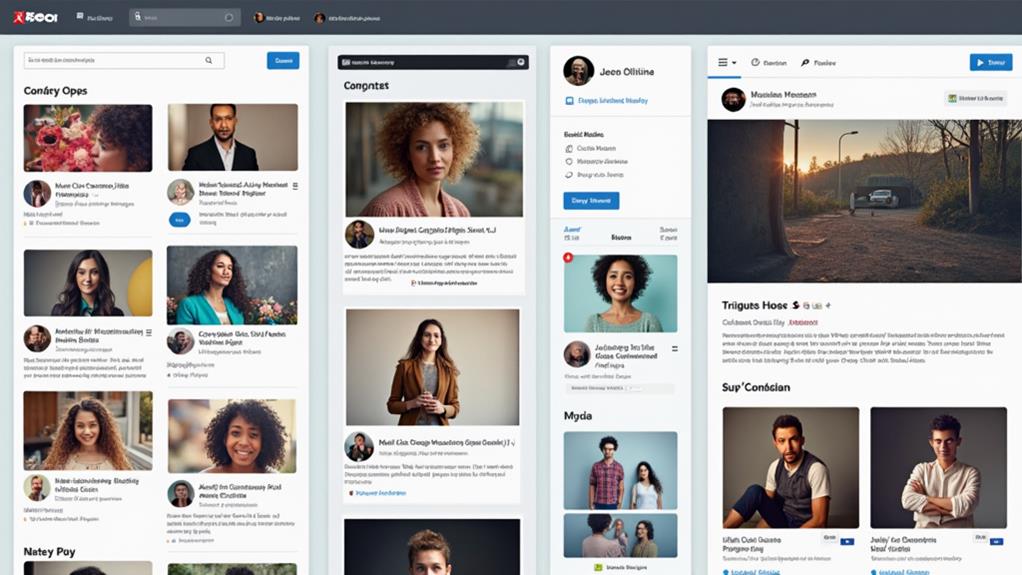To remain compliant with copyright laws in managing user-generated content (UGC), it is essential to secure explicit permissions and licenses from creators. Documenting detailed agreements on usage rights and duration safeguards against infringement. Brands must also address privacy concerns by obtaining clear consent from creators, guaranteeing transparency. Fair use should be cautiously evaluated through its four determining factors: purpose, nature, amount, and market impact. Content moderation, balancing automated tools with human oversight, prevents unauthorized material from reaching the platform. Adhering to these practices guarantees lawful UGC management, offering more insights into maintaining compliance and fostering positive relationships.
Key Takeaways
- Secure explicit permission and licenses from UGC creators to avoid copyright infringement.
- Clearly outline usage terms in user agreements to prevent legal misunderstandings.
- Employ a combination of automated tools and human oversight for effective content moderation.
- Conduct regular audits to ensure compliance with copyright laws and remove infringing content.
- Educate users on copyright implications to promote accountability and reduce infringement risks.
Legal Considerations for UGC
When it comes to legal considerations for user-generated content (UGC), understanding copyright protections is paramount. UGC is inherently protected by copyright laws from the moment of creation, requiring brands to secure explicit permission from creators to use their content, thereby avoiding infringement.
This underscores the importance of clear user agreements, which should delineate terms regarding content usage, guaranteeing both parties' rights and responsibilities are acknowledged.
Trademark implications also play a critical role in managing UGC. Brands must be cautious not to infringe upon trademarks when using UGC, as incorporating trademarked material without authorization can lead to legal challenges.
Clear guidance within user agreements can mitigate these risks by specifying how trademarks are used and securing necessary permissions.
Moreover, the Digital Millennium Copyright Act (DMCA) offers a structured approach for managing UGC. It provides safe harbor protections for platforms, contingent upon promptly removing infringing content.
This legal framework guarantees that platforms maintain compliance while respecting creators' rights.
Copyright Compliance Essentials
To effectively navigate the complexities of copyright compliance in user-generated content (UGC), brands must prioritize obtaining explicit permissions from creators before incorporating their work into marketing strategies.
UGC ownership is automatically conferred to the creator at the moment of creation, thereby requiring businesses to secure necessary permissions to prevent infringement claims. This intrinsic ownership underscores the significance of clearly documented agreements with content creators, detailing the scope and duration of usage rights.
Copyright duration, typically lasting the creator's lifetime plus 70 years, further emphasizes the need for long-term compliance strategies. Understanding the nuances of copyright laws is essential, as misuse can lead to legal disputes and reputational harm.
While the fair use doctrine provides a potential avenue for using copyrighted material without explicit permission, its application is highly subjective and varies by case. This necessitates a thorough understanding of its limitations and prudent application.
Brands must guarantee their UGC usage policies align with copyright standards, implementing regular educational sessions for staff about these laws and UGC rights.
Such proactive measures are significant to maintaining compliance and fostering a culture of respect for intellectual property, thereby safeguarding both legal standing and brand reputation.
Obtaining Permissions and Licenses
Securing explicit permissions and licenses for user-generated content (UGC) is a cornerstone of responsible brand management. To avoid copyright infringement and legal disputes, brands must diligently engage in permission verification with content creators. This involves obtaining clear, documented permissions that detail how the UGC will be used, ensuring both parties have a mutual understanding of the terms, including any potential modifications. Such transparency is crucial in protecting both the creator's rights and the brand's legal standing.
In scenarios where the brand plans to modify the content or utilize it for commercial purposes, a formal license becomes essential. This step in license management provides a structured legal framework that safeguards both the creator's intellectual property and the brand's interests.
Employing rights management tools can markedly streamline this process, offering an efficient method to document and track permissions, thereby simplifying content license management.
Moreover, direct communication with creators is not only a practical approach to securing permissions but also enhances trust, potentially leading to future collaborations. By fostering these relationships, brands open doors to ongoing content sharing opportunities, reinforcing a sustainable and compliant UGC strategy.
Privacy and Consent Practices
While guaranteeing compliance with copyright laws and safeguarding creator rights, obtaining explicit consent from content creators is a fundamental component of privacy and consent practices in UGC management. This process not only protects the intellectual property of creators but also fosters user engagement by building trust and transparency.
Clear communication regarding the intended use of user-generated content, including specifics on how and where it will be displayed, is vital. It establishes a foundation of transparency and trust, which are essential for ethical guidelines in UGC practices.
Consent forms should be straightforward and well-documented, providing users with a clear understanding of their rights and the nature of the permissions they are granting. Such documentation guarantees that creators are fully informed, aligning with ethical guidelines and privacy regulations.
Users must also be informed of their right to revoke consent at any time, a practice that upholds ethical standards and reinforces compliance with privacy laws.
Implementing best practices for consent, such as personalized requests and clear terms of use, not only enhances brand credibility but also strengthens relationships with the creator community. These best practices guarantee that user engagement remains robust and ethically sound.
Understanding Fair Use
Understanding fair use is vital for navigating the complexities of copyright law, particularly in the domain of user-generated content (UGC). Fair use permits limited use of copyrighted material without explicit permission, informed by a legal framework evaluating four significant factors: the purpose and character of the use, the nature of the copyrighted work, the amount used, and the effect on the market value of the original work.
Importantly, transformative use, which introduces new expression or meaning to the original work, is more likely to be deemed fair use. This emphasizes the necessity for originality and creativity in adaptations, distinguishing them from mere reproductions.
Non-commercial use generally strengthens a fair use claim, as it suggests a reduced impact on the market for the original work. However, it is crucial to acknowledge that fair use determinations are inherently subjective, analyzed on a case-by-case basis. Each situation's unique context dictates the outcome, underscoring the absence of a universal rule.
Consequently, brands integrating UGC should conduct rigorous examinations of their content, mindful of fair use's nuances, to mitigate the risk of copyright infringement and preempt potential legal challenges. This strategic approach guarantees compliance while fostering innovation.
Effective Content Moderation
Effective content moderation consistently plays an essential role in managing user-generated content (UGC) on digital platforms, guaranteeing adherence to copyright laws and community guidelines. By implementing a robust system that combines automated tools and human oversight, platforms can effectively monitor and manage content to prevent copyright infringements.
Automated tools, such as AI-driven content moderation technologies, are instrumental in swiftly identifying potentially infringing material. These tools provide an initial layer of defense, efficiently scanning large volumes of content for copyright violations.
However, the complexity and nuance often inherent in UGC necessitate human oversight as well. Human moderators are fundamental in evaluating cases that automated tools flag, applying contextual judgment where necessary. Regular content audits further enhance compliance by identifying and removing infringing or inappropriate content, thereby safeguarding the brand from legal risks.
Moreover, educating users about acceptable content and copyright implications is essential for prevention. Clear communication of guidelines can greatly reduce problematic posts.
Additionally, establishing clear reporting and takedown processes guarantees prompt responses to infringement claims, maintaining platform integrity. By balancing technology with human expertise, digital platforms can uphold legal standards and foster a compliant community environment.
Addressing copyright infringements and handling user complaints are vital components of managing user-generated content on digital platforms. Infringements occur when users upload copyrighted content without permission, which can result in legal action against both the user and the hosting platform. This underscores the importance of robust content moderation systems to mitigate infringement consequences.
The Digital Millennium Copyright Act (DMCA) provides a legal framework for managing such instances, enabling copyright holders to issue takedown notices. Platforms that comply with these requests benefit from safe harbor protections, shielding them from liability.
To enhance user accountability and reduce the risk of infringing content, brands should implement regular content audits and educate users on copyright implications. This proactive approach fosters a culture of respect for intellectual property.
Additionally, establishing clear complaint handling procedures is essential. Efficiently addressing UGC-related disputes not only mitigates potential reputational damage but also enhances user trust.
Employing effective moderation strategies, including both automated tools and human oversight, is imperative in filtering out infringing or defamatory content before publication. By doing so, brands can meaningfully reduce legal risks and maintain the integrity of their digital platforms.
Frequently Asked Questions
How Can Brands Incentivize Users to Create and Share UGC?
Brands can incentivize user-generated content by understanding user motivations and offering content rewards. Initiatives like exclusive access, recognition, or tangible incentives can effectively drive user engagement, fostering a community of enthusiastic content creators aligned with brand values.
What Tools Help Track and Manage UGC Permissions Effectively?
Effective tools for managing user-generated content permissions include content management systems with integrated permission tracking features, such as Rightsline and FADEL. These platforms streamline permission acquisition and provide detailed oversight of user consent and content usage rights.
How Should Brands Handle Misleading or False UGC?
Brands should promptly address misleading content to maintain user trust by fact-checking submissions, providing corrections, and transparently communicating with their audience. Implementing robust moderation protocols guarantees the authenticity of user-generated content and preserves brand integrity.
What Are the Best Practices for Collaborating With UGC Influencers?
When collaborating with UGC influencers, establish a clear influencer outreach plan aligning with your content strategy. Define objectives, provide creative guidelines, and guarantee open communication to foster authentic content that resonates with your audience and enhances brand visibility.
How Can Brands Measure the Impact of UGC on Their Campaign Success?
Brands can measure the impact of UGC on campaign success by employing UGC analytics strategies, focusing on campaign performance metrics such as engagement rates, conversion rates, and audience growth, hence offering a precise evaluation of campaign effectiveness and reach.
Conclusion
Compliance with copyright laws in user-generated content (UGC) demands a detailed understanding of legal considerations, including obtaining necessary permissions and licenses. Adhering to privacy and consent practices guarantees respect for contributors' rights. Mastery of fair use principles is essential for lawful content utilization. Effective content moderation is necessary to identify potential infringements promptly. Steering through complaints and addressing infringements must be handled with precision to maintain compliance and uphold the integrity of the content platform.




